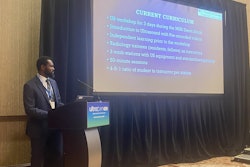More outpatient scheduling blocks may reduce resident burnout without reducing medical knowledge, according to an article published in JAMA Network Open.
A team led by Daniel Heppe, MD, from the University of Colorado School of Medicine and VA Eastern Colorado Health Care System in Aurora, found that residents reported improved overall health and well-being, as well as reported improved ability to attend educational sessions without skimping out on clinical reasoning or skills.
"Burnout is a work-related syndrome of depersonalization, emotional exhaustion, and low personal achievement that is prevalent among internal medicine resident trainees," Heppe and colleagues wrote, noting that "training schedules that create protected time for residents to engage in activities such as scholarship and quality improvement are needed."
The Heppe team has been evaluating the format and content of residency programs for several years now. This time, it evaluated the association of a 4 + 4 block schedule (rotating four inpatient weeks with four outpatient weeks) compared to a 4 + 1 block schedule (rotating four inpatient weeks with one outpatient week) to measure schedule-associated burnout, wellness, and self-reported professional engagement, and clinical preparedness.
Beginning with the academic year 2019-2020, the internal medicine residency program (IMRP) at a university, a U.S. Veterans Administration hospital, and a local hospital, all located in Colorado, implemented a new 4 + 4 block scheduling system.
In a nonrandomized, preintervention, and postintervention survey study, the researchers included residents in the categorical, hospitalist, and primary care tracks in postgraduate years one and two (PGY1 and PGY2). Resident schedules alternated between four-week inpatient call-based rotations and 4-week ambulatory noncall-based rotations to see if the 4 + 4 block intervention showed improvements without reducing medical knowledge, as assessed by in-training examination scores or perceived clinical readiness.
Residents were invited to voluntarily complete surveys assessing burnout, educational outcomes, and quality of life both before and after the schedule design change. Of the 313 eligible residents, 216 completed the intervention block schedule surveys -- 107 respondents (49.5%) were women, 109 (50.5%) were men, and 119 (55.1%) of the total respondents were PGY1 residents. The PGY1 residents had higher response rates than the PGY2 residents (78.2% vs. 60.2%).
Using the Maslach Burnout Inventory – Human Services Survey for Medical Personnel, the researchers assessed burnout in three subcategories: personal achievement, depersonalization, and emotional exhaustion. A secondary outcomes survey assessed morale, health, and well-being. Heppe and colleagues noted the following four important points about the 4 + 4 block schedule intervention:
- Postintervention cohorts scored higher in self-perceived professionalism, job satisfaction, morale, and satisfaction with career choice.
- Residents reported improved health and overall well-being with the 4-plus-4 block.
- By smoothing the curve of inpatient opportunities by spacing them at intervals, residents reported improved ability to attend educational sessions without decrement in clinical reasoning or acquisition of clinical skills.
- Residents felt they had more time for friends and family and activities outside of work.
However, Heppe and colleagues noted a dropoff in survey responses over time, the study's timing with the COVID-19 pandemic, and they cautioned the possibility of nonresponse bias in the results.
"These results suggest that specific X + Y block combinations may be better than others and warrant consideration for investigation and adoption by other IMRPs nationwide. Further study is needed to determine whether these results persist after graduation from residency," the authors concluded.




















